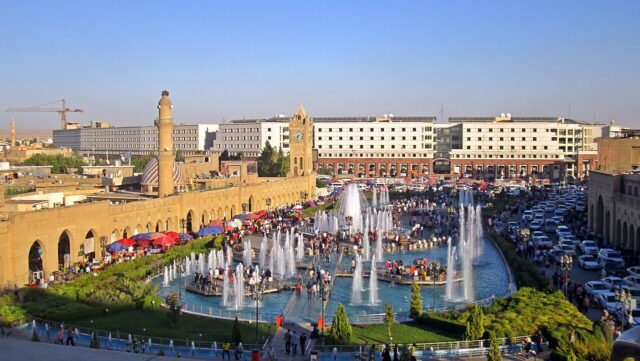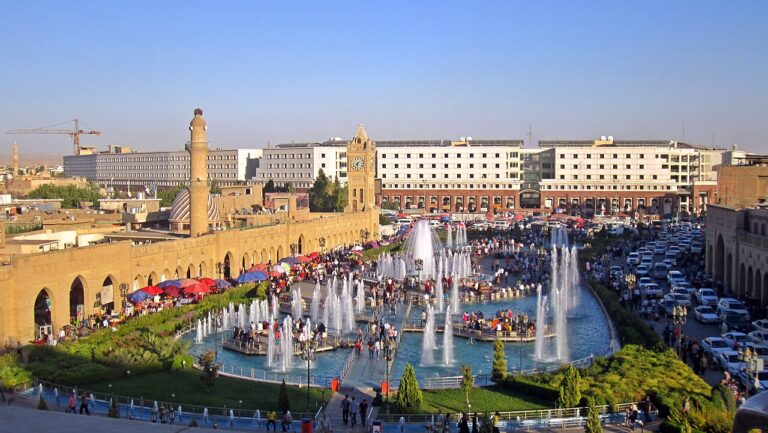 The main square in Erbil, Kurdistan, just south of the southern gate of the citadel, between the two main bazaar areas (Credit: Ask Gudmundsen, CC BY-SA 3.0, via Wikimedia Commons)
The main square in Erbil, Kurdistan, just south of the southern gate of the citadel, between the two main bazaar areas (Credit: Ask Gudmundsen, CC BY-SA 3.0, via Wikimedia Commons)
Geopolitics Report ISSN 2785-2598 Volume 41 Issue 20
Special Eurasia OSINT Team
executive summary
The Kurdistan Region has recently seen a significant increase in tourism, with more than 1.5 million visitors in the past three months. An ambitious plan announced by the Kurdistan Tourism Authority aims to attract 20 million tourists a year by 2030, in line with the government’s economic diversification plan.
However, political divisions, regional tensions, and internal conflicts create a complex geopolitical situation that contrasts with the region’s tourism potential.
Despite these challenges, the Kurdistan region is positioned as a promising tourist destination due to its unique blend of cultural heritage and natural beauty.
Mitigating risks, promoting regional dialogue and strengthening infrastructure are critical to realizing the region’s tourism aspirations and ensuring sustainable growth.
Background information
The Kurdistan region boasts a rich tapestry of historical and cultural attractions, including the 6,000-year-old Erbil Citadel, a UNESCO World Heritage Site, and diverse gastronomic experiences. According to recent statistics, the region has experienced a remarkable surge in tourism, with more than 1.5 million tourists visiting in the past three months alone.
Ibrahim Abdulmadjid, spokesman for the Iraqi Kurdistan Tourism Authority, highlighted the growing attractiveness of the region, citing its diverse attractions and year-round accessibility. Amal Jalal, Chairman of the Kurdistan Regional Tourism Commission, announced an ambitious project aimed at further strengthening the sector, with the goal of attracting 20 million tourists a year by 2030.
Kurdistan, with its rich cultural heritage, ruins and breathtaking landscapes, has the potential to become a major tourist destination, consistent with the government’s economic diversification policy.
Kurdistan: geopolitical scenario
Geopolitical dynamics within Iraqi Kurdistan represent a multifaceted interplay of regional power struggles, energy interests, and internal political cleavages. Of particular importance is the persistent rift between the Kurdistan Democratic Party (KDP) and the Patriotic Union of Kurdistan (PUK), which not only perpetuates internal instability but also impedes a cohesive governance structure.
Among these challenges, the region’s rich gas reserves could be a game-changer in the broader Middle East geopolitical landscape. But internal discord in the region and strained relations with the central government in Baghdad are preventing that potential from being realized. Despite its strategic importance in the region’s energy dynamics, Erbil’s history of reliance on Baghdad for oversight of the energy sector has constrained its autonomy.
Constructive regional dialogue is essential to effectively navigate the complex issues surrounding Kurdish energy exports. Fostering partnerships with Gulf states and the West could create opportunities to ease Iranian opposition and strengthen energy cooperation.
The geopolitical implications of turmoil within Kurdistan extend beyond energy dynamics and could exacerbate instability in Iraq and the entire Middle East region, requiring careful consideration and strategic planning.
risk assessment
Although the Kurdistan Region has immense potential for tourism development, several risks must be considered. Political instability within Iraq, coupled with regional tensions and local terrorist groups, could disrupt the sector’s growth trajectory. Safety concerns and infrastructure deficiencies may hinder the realization of the region’s tourism goals.
Scenario analysis
optimistic scenario. Erbil has successfully implemented its tourism development plan and is seeing an increase in domestic and international tourists. Political stability and effective marketing efforts will propel the sector towards achieving ambitious goals, fostering economic growth and diversification. Medium scenario. Despite facing occasional challenges, such as sporadic security incidents and economic fluctuations, Kurdistan’s tourism sector maintains a stable growth trajectory. Pragmatic policies and adaptation strategies can help the region overcome the uncertainty, albeit at a slightly slower pace than expected. pessimistic scenario. Rising regional tensions and prolonged political instability undermine regional tourism expectations. Tourist numbers have stagnated or declined, investment confidence has declined, and the industry is struggling to recover, resulting in major setbacks to economic development and stability.
Conclusion/Recommendations
Kurdistan’s tourism sector has high hopes for economic growth and diversification. To take advantage of this potential, stakeholders must prioritize efforts to strengthen security, improve infrastructure, and streamline regulatory processes. Collaborative partnerships between government agencies, private investors and international stakeholders are essential to realizing the region’s tourism ambitions.
It is essential to develop risk management strategies and contingency plans to mitigate potential threats and ensure sector resilience in the face of challenges. By promoting a suitable environment for tourism development, the Kurdistan Region can emerge as a premier destination on the world stage and offer unparalleled experiences to visitors from all over the world.
If you would like further information, reports and risk assessments on Kurdistan and Iraq, please contact us at info@specialeurasia.com.

